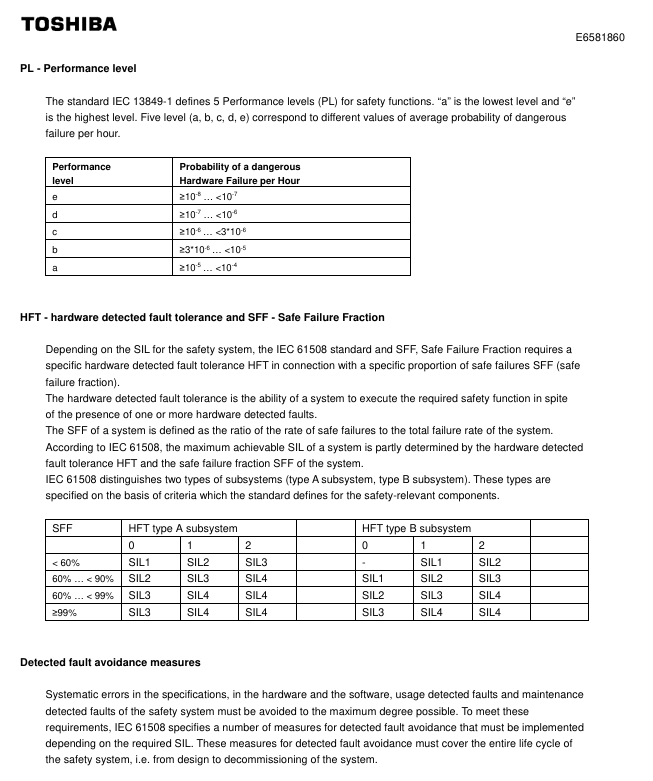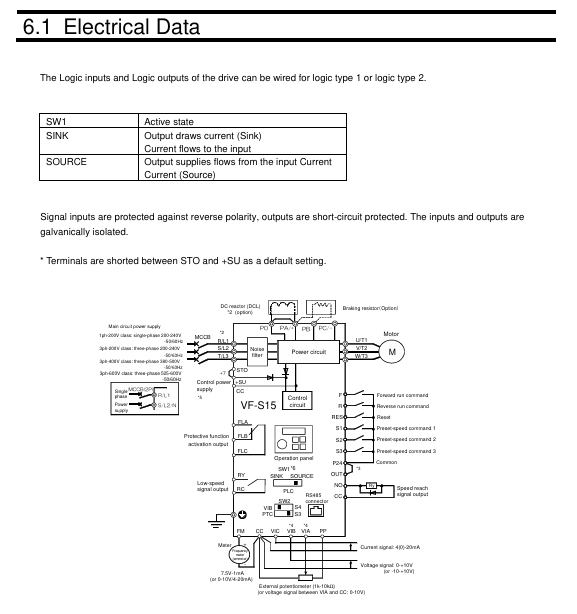TOSHIBA VF-S15 frequency converter
Example of input voltage level frequency converter model
Single phase 200V-240V VFS52S-2002PL__/- W1/Y-A *, VFS52S-2004PL__/- W1/Y-A*
Three phase 200V-240V VFS15-2002PM_/- W1/Y-A *, VFS15-2004PM_/- W1/Y-A*
Three phase 380V-500V VFS15-4004PL_/- W1/Y-A *, VFS15-4007PL_/- W1/Y-A*
Three phase 525V-600V VFS15-6015P_/- W1/Y-A *, VFS15-6022P_/- W1/Y-A*
TOSHIBA VF-S15 frequency converter
Basic information of the document
Scope of Application
The document specifically lists the applicable models (including multiple voltage levels) for the Toshiba VF-S15 series frequency converter, as shown in the table below. Models marked with suffixes such as "Y-A38" and "Y-A65" are not applicable.
Example of input voltage level frequency converter model
Single phase 200V-240V VFS52S-2002PL__/- W1/Y-A *, VFS52S-2004PL__/- W1/Y-A*
Three phase 200V-240V VFS15-2002PM_/- W1/Y-A *, VFS15-2004PM_/- W1/Y-A*
Three phase 380V-500V VFS15-4004PL_/- W1/Y-A *, VFS15-4007PL_/- W1/Y-A*
Three phase 525V-600V VFS15-6015P_/- W1/Y-A *, VFS15-6022P_/- W1/Y-A*
Safety warnings and personnel qualifications
1. Warning system
The document categorizes safety warnings into two types, specifying risk levels and response requirements:
Warning type meaning Typical scenarios
Warning operation errors may result in death or serious injury. Touching live cables, repairing without discharge, and short circuiting DC bus capacitors
Incorrect operation of the solution may result in minor injuries or equipment damage, voltage incompatibility, capacitor aging, and performance degradation
2. Core security taboos (Warning level)
Do not touch live cables (such as printed circuit boards) inside the frequency converter, and use insulated tools;
Before maintenance, it is necessary to follow the process of "power off → paste the prohibition closing label → lock the power-off switch → wait for 15 minutes to discharge → measure the DC bus voltage<42V";
Do not short-circuit PA/+and PC/- terminals or DC bus capacitors;
Before powering on, all cover plates must be installed and closed.
3. Personnel qualification requirements
Only qualified personnel are allowed to operate (subject to the following conditions):
Having received safety training, able to identify and mitigate risks;
Familiar with this manual and product documentation, proficient in electrical/mechanical system knowledge;
Understand international/national electrical codes and accident prevention regulations.

Detailed explanation of core security functions
1. STO (Safe Torque Off)
Function definition: To put the motor into a torque free state (prohibiting motor start or free stop), cut off the energy supply to the motor, corresponding to IEC 60204-1 stop category 0 (uncontrolled stop).
**According to * *: IEC 61800-5-2 § 4.2.2.2, it should be noted that additional mechanical brakes are required for suspended load scenarios, and electronic components cannot replace anti electric shock isolation measures.
Security level:
Configuration method SIL (IEC 61508) PL (ISO 13849-1) EN 954-1 category
With/without Preventa module SIL 2 PL d 3
Key parameters: response time<10ms, logic input 0<2V, 1>17V, impedance 1.5k Ω.
Module requirements: Mechanical applications (compliant with IEC 60204-1) require mandatory use of Preventa modules (such as XPS AF) to prevent accidental restarts; Use as needed in other scenarios.
2. SS1 (Safe Stop 1, Safety Stop Class 1, Type C)
Function definition: First, slow down the motor according to the specified time delay. After the delay ends, trigger the STO function, corresponding to IEC 60204-1 stop category 1 (control stop).
Normative basis: IEC 61800-5-2 § 4.2.2.2, requires the use of specific safety relays to implement delay logic.
Security level:
Configuration method SIL (IEC 61508) PL (ISO 13849-1) EN 954-1 category
STO+Previnta module (such as XPS AV) SIL 2 PL d 3
Application logic: The deceleration delay time needs to be set according to the actual scenario, and the motor will enter a torque free state after the delay ends.

Compliance standards and safety performance
1. Follow the standards
Specific core requirements for standard categories
IEC 61800 series variable speed electric drive system safety requirements for drive systems
Functional Safety IEC 61508 Ed.2 Electrical/Electronic/Programmable Systems Functional Safety, Defining SIL Levels
Mechanical safety ISO 13849-1/2, EN 954-1 Safety components of mechanical control systems, defining PL levels and categories
Process Safety IEC 62061 Process Industry Safety Instrumented Systems, Distinguishing Global/Component SIL
2. Safety performance indicators
Taking the STO function as an example, the key performance parameters are shown in the following table:
Explanation of Indicator Values
SFF (Safety Failure Score) 96.7% represents the proportion of safety failures to total failures, reflecting the safety of the system
MTTFd (Mean Time to Failure) is the average interval between system failures in the year 16200
PFHequ_1y (annual hazard failure probability) 7.04 FIT 1FIT=10 ⁻⁹ times/hour, which means the annual failure probability is extremely low
HFT (Hardware Fault Tolerance) 1 allows one hardware fault to maintain safety functionality
Equipment type B complies with the definition of Class B subsystems in IEC 61508
System architecture and application limitations
1. Authentication architecture (3 types)
The document provides three certified security system architectures, adapted to different application scenarios:
Architecture Type Applicable Scenarios Core Configuration Compliance Standards
- EMERSON
- Honeywell
- CTI
- Rolls-Royce
- General Electric
- Woodward
- Yaskawa
- xYCOM
- Motorola
- Siemens
- Rockwell
- ABB
- B&R
- HIMA
- Construction site
- electricity
- Automobile market
- PLC
- DCS
- Motor drivers
- VSD
- Implications
- cement
- CO2
- CEM
- methane
- Artificial intelligence
- Titanic
- Solar energy
- Hydrogen fuel cell
- Hydrogen and fuel cells
- Hydrogen and oxygen fuel cells
- tyre
- Chemical fiber
- dynamo
- corpuscle
- Pulp and paper
- printing
- fossil
- FANUC
- Food and beverage
- Life science
- Sewage treatment
- Personal care
- electricity
- boats
- infrastructure
- Automobile industry
- metallurgy
- Nuclear power generation
- Geothermal power generation
- Water and wastewater
- Infrastructure construction
- Mine hazard
- steel
- papermaking
- Natural gas industry
- Infrastructure construction
- Power and energy
- Rubber and plastic
- Renewable energy
- pharmacy
- mining
- Plastic industry
- Schneider
- Kongsberg
- NI
- Wind energy
- International petroleum
- International new energy network
- gas
- WATLOW
- ProSoft
- SEW
- wind
- ADVANCED
- Reliance
- YOKOGAWA
- TRICONEX
- FOXBORO
- METSO
- MAN
- Advantest
- ADVANCED
- ALSTOM
- Control Wave
- AB
- AMAT
- STUDER
- KONGSBERG
- MOTOROLA
- DANAHER MOTION
- Bently
- Galil
- EATON
- MOLEX
- Triconex
- DEIF
- B&W
- ZYGO
- Aerotech
- DANFOSS
- KOLLMORGEN
- Beijer
- Endress+Hauser
- MOOG
- KB
- Moxa
- Rexroth
- YAMAHA
- Johnson
- Westinghouse
- WAGO
- TOSHIBA


Email:wang@kongjiangauto.com





























































































































